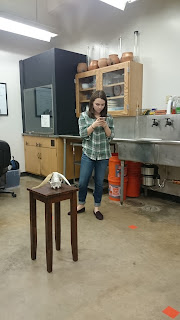Earlier this month, on Saturday February 6th, we continued learning about 3D scanning and modeling from Dr. Selden. One of the projects we focused on that day was using photogrammetry to create 3D models. To do this, we went the Daniels Family Cemetery, a private cemetery in Dallas, which the Daniels Family allowed us to visit. While there, we took photos of two Woodmen of the World grave markers.
Dr. Selden explained to us that these markers were provided by the insurance company Woodmen of the World Insurance, operated through WoodmenLife, upon the death of a customer.
Before we could begin, Dr. Seldon explained to us how to take photos for a 3D model. Here is a photo that shows Dr. Selden demonstrating how to take photos of one of the grave markers.
The method we used at the cemetery is very similar to the way we took photos of Rachel's Pet when we were first experimenting with Autodesk 123D Catch, which we have discussed in a previous blog post. We began by standing in front of the marker, and then slowly walking around it in a circle, making sure to take one photo for each step. When we completed the circle, we had about 20 photos of the marker.
Here is a photo of Sam and I holding down grass that had grown around the base of a marker, while Christine takes photos using this method.
After this, we had to take photos at a higher angle in order to capture the top of the marker. Without this step, the 3D model would have had a hole at the top. Here is Dr. Selden showing Christine how to take photos at a higher angle.
The last step is to take detail shots of the marker. This step was very simple, and only required a few photos of the Woodmen of the World emblem, and some other shots of the branches on the marker. This made the details of the 3D model clearer than they would have been if we had just used the photos from the first two steps.
After that final step, we headed back to the lab to stitch together all of our photos and create the 3D model! But first, Dr. Selden took a selfie.
From left to right: Dr. Selden (foreground), Rachel, Lauren, Sam, Chrisitne, and Dr. Eiselt (background)
When we got back to the lab, we used a program called Autodesk 123D Catch, the same program we used to create the model of Rachel's Pet, to stitch the photos together and create the model. It is a free, easy to use program that you can download
here.
While we do not have the 3D models of the grave markers that we took photos of, you can see examples of other models of Woodmen of the World markers
here on Dr. Selden's blog,
crhr:archaeology. If you want to learn more about photogrammetry or Autodesk 123D Catch, you can read
this article, also on Dr. Selden's blog.




































